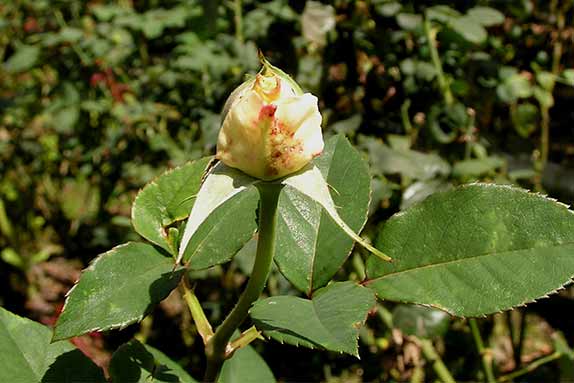Thrips are tiny winged insects that can cause significant damage to rose bushes. They feed on the sap inside rose buds and flowers, causing them to become discolored and malformed. Left uncontrolled, thrips can ruin an entire rose garden. Fortunately, there are several effective methods for treating thrips on roses.
Identifying Thrips
Thrips are slender insects less than 1/8th of an inch long. They can be brown, yellow, or black in color. Thrips damage is usually the first sign of an infestation. Look for
- Brown streaks or spots on rose petals
- Deformed buds that fail to open
- Flowers with browned edges
Check inside damaged buds – you may see tiny insects moving around, Thrips can also be identified by tapping a flower over a white sheet of paper, The small insects will be visible moving on the paper,
Cultural Control Methods
Remove Weeds & Debris
Thrips overwinter in leaf litter, weeds, and other debris around the garden. Removing these potential hiding spots reduces the thrip population. Clean up thoroughly around roses in fall and early spring.
Water from Below
Thrips are weak fliers and get blown into gardens by the wind. Watering roses from below, at soil level, reduces their access to plants. Avoid overhead watering that can spread thrips.
Attract Beneficial Insects
Natural predators like ladybugs, lacewings, and minute pirate bugs will prey on thrips. Plant flowers that attract these beneficial insects to your garden. Marigolds, zinnias, and members of the daisy family are good choices.
Pesticide Sprays
Insecticidal soaps, horticultural oils, and neem oil are organic pesticide options for controlling thrips. These sprays smother adults on contact and can reduce populations. Apply liberally to leaf undersides every 5-7 days while thrips are active. More than one treatment is usually needed.
For severe infestations, synthetic insecticides like pyrethrins may be more effective. Look for products labeled specifically for thrips control. Be sure to follow all safety precautions when using any pesticide.
Target Immature Thrips
Sprays generally only kill adult thrips on contact. For better control, systemic insecticides are recommended. These are taken up by the rose plant and kill immature thrips feeding inside buds and flowers. Common examples include acephate and spinosad.
Biological Controls
Releasing predatory insects is an organic way to reduce thrips without using any sprays. Lacewing and minute pirate bug eggs can be purchased and introduced. They will hatch and feed on thrips larvae. For best effect, release predators early in the season before thrips populations explode.
Beneficial nematodes are microscopic roundworms that prey on thrips pupae in soil. Apply nematodes like Steinernema feltiae around roses in early spring to control new generations. They persist longer than insect releases.
IPM Approach
Integrated pest management (IPM) combines several control tactics into a thrip management plan:
- Clean up debris where thrips overwinter
- Release predators and nematodes
- Apply insecticidal soap or neem oil
- Use systemic insecticides if needed
- Introduce more beneficial insects
By utilizing multiple methods, thrips can be kept at bay without relying solely on pesticide sprays. It takes vigilance to monitor for thrips and be proactive, but this approach protects roses while minimizing chemical use.
Preventing Thrips
Thrips management in roses takes persistence, but preventing infestations is easier. Follow these tips to avoid thrip damage:
- Don’t plant roses near weedy areas
- Water from below to avoid spreading thrips
- Inspect flowers frequently for signs of damage
- Act immediately at the first sign of thrips
Catching an infestation early makes treatment much simpler. By taking preventative measures and responding quickly, your roses can thrive thrip-free all season long. A combination of cultural practices, biological control, and targeted pesticide use when necessary will keep these destructive pests under control.
Thrips in the Garden: Damage and Control
FAQ
How do you get rid of thrips permanently?
What kills thrips the best?
What does thrip look like on roses?
Can you save a plant from thrips?
How do you get rid of thrips on roses?
Getting rid of thrips on roses can be a tricky process, but with some patience and dedication, a cure is possible. There are a number of both natural and chemical control methods one can implement in order to eradicate their thrips problem. Due to their short lifespan, thrips can multiply rapidly. The first line of defense is early detection.
Does rose hips thin the blood?
Rose hips can cause thinning of the blood. This is why it is recommended not to take them when you are on blood thinners. This is because the blood might become too thin, and might prevent it from clotting like it should.
How do I Choose an insecticide for thrips on roses?
When selecting an insecticide for thrips on roses, you will want to search for a spray that contains the active ingredient spinosad (spinosyn A+D). This substance is highly effective in taking care of thrips on roses and is commonly found in most insecticides.
Do thrips damage rose plants?
Harmful thrips will cause damage to the petals of your rose plants in the form of silver/brown-spotted streaks on the surface of open petals. This occurs due to the thrips penetrating the tissue of the petals when feeding on the plant sap.
- A Complete Guide to Caring for Yuki Cherry Blossom Shrub - January 23, 2025
- Identifying Red Hot Poker Seeds: What to Look For When Harvesting Torch Lily Pods - January 23, 2025
- A Complete Guide to Harvesting Evening Primrose Seeds - January 23, 2025

